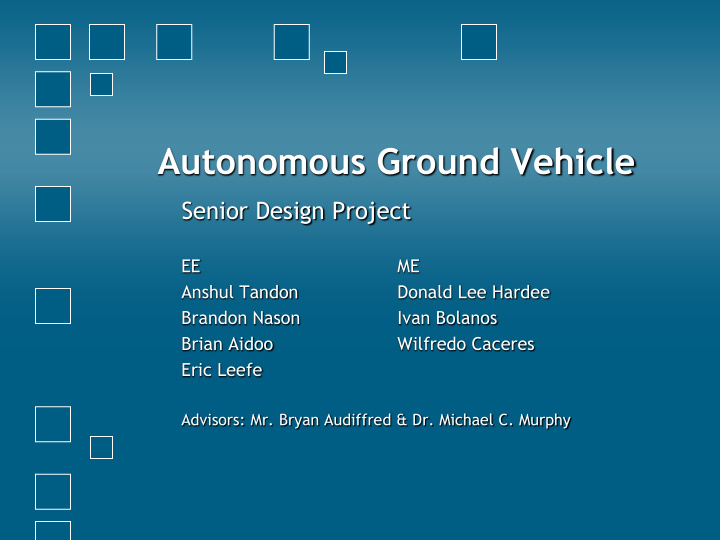



Autonomous Ground Vehicle Senior Design Project EE ME Anshul Tandon Donald Lee Hardee Brandon Nason Ivan Bolanos Brian Aidoo Wilfredo Caceres Eric Leefe Advisors: Mr. Bryan Audiffred & Dr. Michael C. Murphy
IGVC – History and Description • June 8-11, 2007 in Rochester, Michigan, hosted by Oakland University • Autonomous Ground Vehicle Competition Autonomous Challenge − Design Challenge − Navigation Challenge − For more info… Please visit IGVC’s official website: http://www.igvc.org/
Organizational Chart • Software • EStop • Control • Motor • Sensor • Steering • Vision • Speed Control Navigatio Propulsio n n Frame Power • Traction • Recharging • Body Material • Battery
Camera • Requirements − Lane & Pothole Detection • Unibrain – Fire-I 501c − Frame rate – 60 fps − Resolution – 640 x 480 − Light-weight and small − Firewire interface − Color camera Image… http://www.unibrain.com
Laser Rangefinder • Requirements − Obstacle Detection • LMS – 200 / LMS - 291 − Field of view - 180° − Angular resolution – 1-0.25° − Response time – 13-53ms − Scanning range – 80m − RS-232 interface Image… http://www.sick.com
GPS Considerations • Primary Concerns − Accuracy, Interface • Secondary Concerns − Cost, Refresh Rate • Tertiary Concerns − Power Consumption, Acquisition Time
GPS Models • Magellan ADU5 • Advantages: accuracy (90 cm), interface (come in housing with ports) • Disadvantages: cost • Magellan DG16 − Advantages: accuracy (70 cm), refresh rate (20 Hz), cost − Disadvantages: interface (comes only as board) • Novatel ProPak-V3 − Advantages: accuracy (0.45m), refresh rate (20 Hz), interface (housing w/ 3 serial ports & 1 USB) − Disadvantages: cost (~$8000)
Digital Compass • PNI TCM 2.6 − Accuracy – 0.8 degree − Resolution – 0.1 degree
Tires • Coefficient of Static Friction ≈ 0.3 (Car Tires on grass) • Coefficient of Rolling Friction ≈ 0.06 (Car Tires on grass) • Force needed to overcome rolling friction ≈ 53 Newtons Weight: 200 Lbs Tire Radius Max Speed RPM 10 inches 5 mph 168 12 inches 5 mph 140 14 inches 5 mph 120
Steering • Analyzed − Tracks − Passive wheels (Caster Wheels) − Rack and pinion • Chosen − Passive wheels and differential steering
Traction and Steering • Advantages • Disadvantages − Cost Efficient − Hard to control at high speeds − Simple design
Propulsion • Motors Selection − Weight − Speed − Acceleration − Number of driving wheels − Radius driving wheels − Coefficient of rolling friction
Propulsion • The motor we selected is the NPC R-82 TORQUE AMPS RPM HP LB-IN 11 4.4 228 0.11 57 11 216 0.22 103 18 205 0.32 154 25 195 0.41 197 31 186 0.52 247 38 175 0.62 291 45 164 0.71 336 52 153 0.81 381 60 140 0.89 427 67 121 0.95 896 105 STALL
Power System Design • Sealed Lead-Acid Batteries with AGM Technology • Separate Power for Motors and Sensors • Linear Voltage Regulators • Software Integrated Monitoring System • Internal Charging Circuitry
Power System Schematic
Frame • Steel (ANSI 1020) − Carbon steel − Easy to handle (draw, bend, punch) − Fairly inexpensive − Light weight − Tensile Strength of 394.7 MPa • The max stress due to extreeme bending moment is 27 MPa • SF of 14.5 • .5 Sch 40
Safety • Waterproofing − Coated Polyester • Light weight • Very inexpensive • Breathable • Easy to apply and remove • E-Stop − Mechanical • IDEC − 30 mm ( 1.18 inch) − Wireless • Hand held button • Custom circuitry
Processing • Personal Computer • GPU Acceleration • OpenVIDIA Graphics Library • C Programming Language • Multithreading
Summary • Navigation − Camera − Laser rangefinder − Differential GPS Unit − Central Processing Unit • Propulsion − DC motors − Traction providing wheels • Power − Rechargeable efficient batteries • Frame − Strong, light material
Questions / Suggestions • Details – contact area experts − Navigation – Vision Anshul Tandon − Navigation – GPS Eric Leefe − Propulsion Ivan Bolanos − Propulsion Wilfredo Caceres − Power Brian Aidoo − Frame Donald Lee Hardee − Software Brandon Nason
Recommend
More recommend